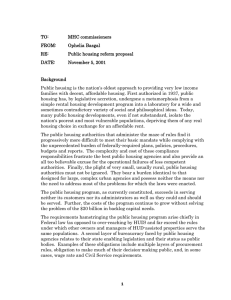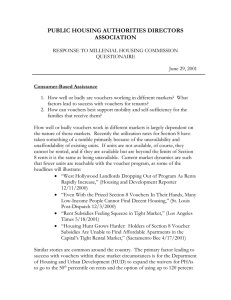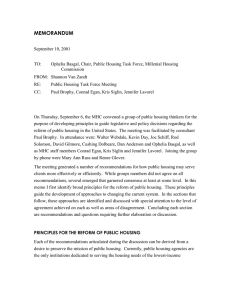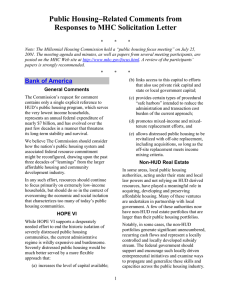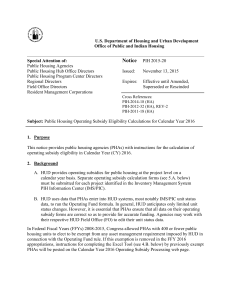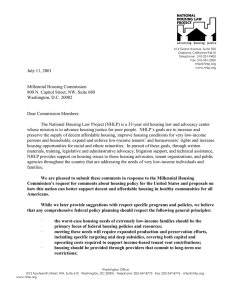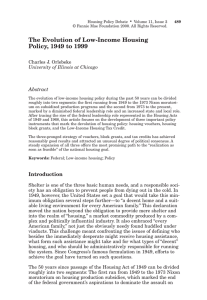Council of Large Public Housing Authorities Background on Public Housing Development
advertisement
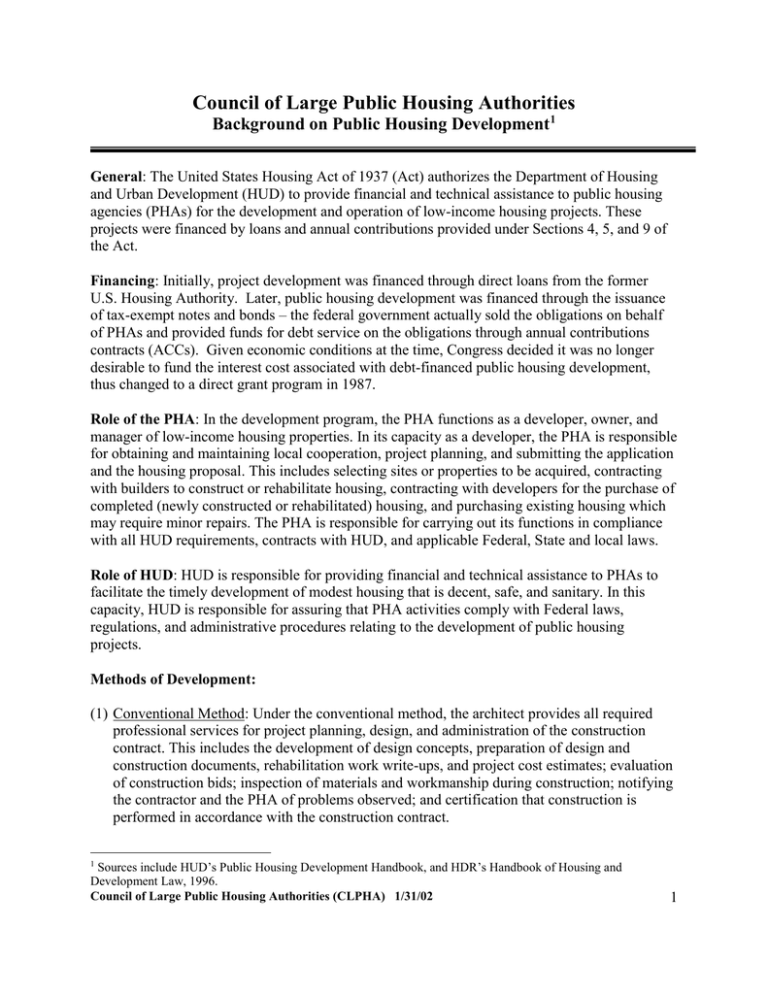
Council of Large Public Housing Authorities Background on Public Housing Development1 General: The United States Housing Act of 1937 (Act) authorizes the Department of Housing and Urban Development (HUD) to provide financial and technical assistance to public housing agencies (PHAs) for the development and operation of low-income housing projects. These projects were financed by loans and annual contributions provided under Sections 4, 5, and 9 of the Act. Financing: Initially, project development was financed through direct loans from the former U.S. Housing Authority. Later, public housing development was financed through the issuance of tax-exempt notes and bonds – the federal government actually sold the obligations on behalf of PHAs and provided funds for debt service on the obligations through annual contributions contracts (ACCs). Given economic conditions at the time, Congress decided it was no longer desirable to fund the interest cost associated with debt-financed public housing development, thus changed to a direct grant program in 1987. Role of the PHA: In the development program, the PHA functions as a developer, owner, and manager of low-income housing properties. In its capacity as a developer, the PHA is responsible for obtaining and maintaining local cooperation, project planning, and submitting the application and the housing proposal. This includes selecting sites or properties to be acquired, contracting with builders to construct or rehabilitate housing, contracting with developers for the purchase of completed (newly constructed or rehabilitated) housing, and purchasing existing housing which may require minor repairs. The PHA is responsible for carrying out its functions in compliance with all HUD requirements, contracts with HUD, and applicable Federal, State and local laws. Role of HUD: HUD is responsible for providing financial and technical assistance to PHAs to facilitate the timely development of modest housing that is decent, safe, and sanitary. In this capacity, HUD is responsible for assuring that PHA activities comply with Federal laws, regulations, and administrative procedures relating to the development of public housing projects. Methods of Development: (1) Conventional Method: Under the conventional method, the architect provides all required professional services for project planning, design, and administration of the construction contract. This includes the development of design concepts, preparation of design and construction documents, rehabilitation work write-ups, and project cost estimates; evaluation of construction bids; inspection of materials and workmanship during construction; notifying the contractor and the PHA of problems observed; and certification that construction is performed in accordance with the construction contract. Sources include HUD’s Public Housing Development Handbook, and HDR’s Handbook of Housing and Development Law, 1996. Council of Large Public Housing Authorities (CLPHA) 1/31/02 1 1 (2) Turnkey Method: Under the turnkey method, the architect is generally responsible only for performing construction inspections and certifying that construction is performed in accordance with the contract of sale. (3) Acquisition Method: Under the acquisition method, an architect usually is not necessary due to the limited scope of repair work. However, the PHA may employ an architect for project planning and administration of the repair contract, if appropriate. See attached chart of public housing construction. Council of Large Public Housing Authorities (CLPHA) 1/31/02 2 Public Housing Construction 400,000 347,585 350,000 300,000 271,952 270,444 Units 250,000 200,000 140,024 150,000 109,095 100,000 61,333 50,000 20,015 Before 1940 1940s 1950s 1960s 1970s 1980s 1990s Total units constructed through 1990s = 1,220,448 Council of Large Public Housing Authorities (CLPHA) 1/31/02 3 Issues in public housing development: 1. Site and Neighborhood Standards Each site proposed for a public housing project must comply with the site and neighborhood standards established by HUD. As generally determined by the local HUD Field Office, each site must be: Adequate in size, exposure, and contour to accommodate the number and type of units proposed. Adequate relative to public facilities and services available or planned for the immediate future. Convenient to public transportation or to places of employment which provide a range of jobs for low-income workers. Accessible to social, religious, recreational, educational, commercial, and health facilities that are adequate to serve the intended occupants of the project. Acceptable relative to density levels that take into account such factors as land costs, topography, planned site use, the number and types of buildings, the anticipated age and number of residents based on the number of bedrooms, local building requirements, and the density prevailing in the neighborhood. Suitable from the standpoint of facilitating and furthering full compliance with the applicable provisions of Title VI of the civil Rights Act of 1964, Title VIII of the Civil Rights Act of 1968 and Executive Order 11063. Not located in an area of minority concentration unless certain exemptions apply. Not located in a racially mixed area, if the project will cause a significant increase in the proportion of minority to non-minority residents in the area. Effective in promoting greater choice of housing opportunities and avoiding undue concentrations of assisted persons in areas containing a high proportion of low-income persons. ► In the future, PHAs – along with local communities and partners – should be given much more discretion in site location while promoting the broad public policy goals of assisting low-income families and expanding housing opportunities. The site and neighborhoods standards of the past would, in many cases, preclude current revitalization strategies and/or the addition of housing resources targeted to distressed neighborhoods. 2. Total Development Costs To hold down project costs, HUD regulations prohibit “elaborate or extravagant” design or materials and require serviceability, efficiency, and economy. Projects must comply with HUD’s minimum property standards. Elderly housing projects must incorporate any special design standards and facilities to meet resident needs. Council of Large Public Housing Authorities (CLPHA) 1/31/02 4 ► In the future – and consistent with current policy on HOPE VI – any HUD-established cost limits should only apply to the public housing resources allocated to any development. 3. HUD Review and Approval Process The HUD review and approval process at each stage of the public housing development process is overly burdensome and costly. ► In the future, the review and approval process must be significantly streamlined. Other issues: 4. Ownership interest & subsidy type ► The Quality Housing and Work Responsibility Act (QHWRA) of 1998 provides new flexibility for PHAs to participate in the development of new affordable housing. PHAs now have the discretion to commit only operating subsidy, only capital subsidy, or both toward any new development. In the future, PHAs should be allowed flexibility in determining the type and level of subsidy to be applied to new development projects. 5. Eligibility ► Newly developed public housing units should be open to the current waiting list of families, including the full range of low-income families eligible under the public housing program (080% of area median income). Future development should support the broad policy goal of mixed-income housing and expanded opportunities for low-income families. CLPHA Recommendations on New Housing Production: (from comments delivered at the MHC Public Housing Forum on July 25, 2001) There is widespread and bipartisan consensus that an affordable housing production initiative targeted to low income households is needed, but what form it will take and the source of funding are still being debated. The Commission’s findings will be critical in shaping this crucial debate. It is critical that any new production program be designed to meet the needs of very low-income residents and provide direct funding to units of local governments, specifically housing authorities. As some of the greatest housing needs are in urban areas, it is paramount that localities be given first access to any production resources. We recommend the following: Council of Large Public Housing Authorities (CLPHA) 1/31/02 5 1. Provide full and direct access for housing authorities to development funds that takes advantage of their far-ranging powers permitting them to play a variety of roles such as developer, partner, land owner and asset manager. Note that the 1998 Quality Housing and Work Responsibility Act (QHWRA) ushers in a new era of wide-sweeping reforms in public housing. The Act enables PHAs to serve a more socially balanced community, allows for more entrepreneurial activity and provides new flexibility in modes of development. 2. Resources should be distributed directly to local governments. 3. Use public housing waiting lists for new units produced under this initiative. 4. Repeal the Faircloth amendment restricting the production of new low-income units. 5. Make Section 8 project-based assistance sufficiently flexible as a development tool. Wider use of project-based assistance can mitigate utilization concerns. 6. Site and neighborhood standards should support revitalization strategies. Elusive and often out-dated deconcentration and mobility strategies should not inadvertently starve neighborhoods that can be revitalized with infusions of capital. 7. Income mixing is critical and flexibility in implementation is needed because of the variation in housing need and market conditions across the country. 8. Provide for hard replacements units lost in HOPE VI redevelopment. While units being demolished at HOPE VI sites are obsolete and in many cases long-term vacant, they represent a significant loss to the overall supply of affordable housing. The operating subsidy and capital allocation for demolished units should be preserved for use in other development initiatives. Council of Large Public Housing Authorities (CLPHA) 1/31/02 6





